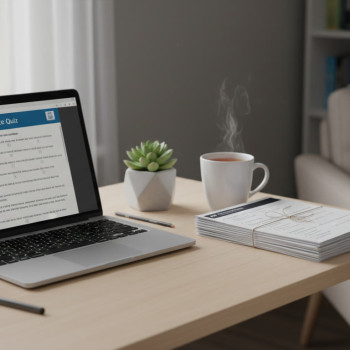Why Historical Thinking and Synthesis Matter for AP Students
At its heart, historical thinking is about connecting the past to the present. For AP students, especially those tackling AP United States History, AP World History, AP European History, or history-related synthesis prompts, the ability to synthesize is not just a test skill — it’s a way of thinking that helps you argue convincingly, read deeply, and place events in meaningful context. The College Board rewards students who can take disparate pieces of evidence and weave them into a coherent explanation that speaks to both continuity and change.
What the College Board Means by Synthesis
Synthesis asks you to go beyond summarizing facts. It requires you to: explain connections across time or geography, bring in insights from other fields (like economics or literature), or relate historical evidence to modern-day issues. In effect, synthesis transforms historical knowledge from a static list of facts into an interpretive tool for understanding the world today.

How Synthesis Shows Up on AP Exams
On AP exams, synthesis is most often assessed in long essay questions (LEQs) and document-based questions (DBQs). Instead of simply identifying causes or effects, you’re asked to construct an argument that links historical developments to a larger thread — sometimes reaching into contemporary relevance.
Typical Synthesis Expectations
- Demonstrate a clear thesis that integrates multiple perspectives.
- Use evidence from documents and outside knowledge.
- Connect your argument to a different historical period, geographic area, or to a modern phenomenon.
- Explain the significance of those connections — why the comparison or linkage matters.
Steps to Mastering Synthesis — A Practical Roadmap
Learning synthesis is like learning to cook: you start with ingredients (facts and sources), learn techniques (analysis and comparison), and eventually create dishes that surprise and satisfy (nuanced essays). Here’s a repeatable roadmap you can practice before the AP exam.
1. Start With a Strong, Flexible Thesis
Your thesis should answer the prompt directly, and also point toward the synthesis you will make. Think of it as a promise: you will connect X and Y and explain why their relationship matters. A flexible thesis leaves room to incorporate evidence that you discover while writing.
2. Organize Evidence As You Read
When working with documents, label each one with a quick note: POV (point of view), purpose, audience, and how it could link to a contemporary issue. Keep an ‘outside knowledge’ list of 6–8 facts or examples that can be readily deployed. Efficiency here saves writing time under exam pressure.
3. Make the Explicit Connection
Don’t assume the grader sees your logic. After presenting evidence, add an explicit sentence that ties it to your synthesis point: “This parallels modern X because…” or “Similarly, in today’s context…”. This is where many essays earn a higher synthesis score: clarity of linkage.
4. Use Comparative or Thematic Frames
Two reliable synthesis strategies are:
- Comparative frame — contrast the historical case with another time or place.
- Thematic frame — connect a historical phenomenon to a broader theme (migration, nationalism, technology) that resonates today.
Examples: Turning Historical Evidence Into Contemporary Insight
Examples clarify what synthesis looks like in practice. Below are two model mini-paragraphs that show the move from evidence to synthesis.
Example 1: Labor Movements and Gig Economy
Evidence: Early 20th-century labor strikes highlighted workers’ demands for safer conditions and fair pay. Linking sentence: Those demands echo in today’s gig-economy debates, where platform-based workers seek benefits and representation. Synthesis: By comparing the rise of unions with modern collective actions like app-based worker organizing, you can show how industrialization and technological change repeatedly force societies to redefine labor rights.
Example 2: Public Health Responses — 1918 to 2020s
Evidence: During the 1918 influenza pandemic, cities that implemented mask mandates and social restrictions often saw lower mortality rates. Linking sentence: Similarly, recent public-health crises in the 2020s show the tension between public safety and individual liberties. Synthesis: This comparison lets you analyze patterns in state authority, public compliance, and the politicization of science across a century.
Study Habits to Build Your Synthesis Muscle
Practice matters. You can’t improvise high-quality synthesis without deliberate practice. Here are study habits that embed synthesis thinking into your exam prep.
Weekly Practice Routine
- Pick one primary source or short DBQ each week and practice making three different synthesis links: (a) to another era, (b) to a different region, and (c) to a modern issue.
- Draft one timed LEQ per week using a comparative or thematic synthesis framework.
- Review graded essays and rewrite the thesis to be stronger or more explicit about the synthesis.
Active Note-Taking Strategy
Use a two-column notebook: left column for evidence and context, right column for connections — “This reminds me of…” or “This matters today because…”. Over time your right column will become a library of synthesis hooks.

How to Structure a Synthesis-Driven AP Essay
A clear structure helps you deploy synthesis under timed conditions. Below is a template you can adapt.
Essay Structure Template
- Intro: Strong thesis that includes your synthesis claim.
- Body Paragraph 1: Present evidence and analysis; make a comparative or thematic connection.
- Body Paragraph 2: Bring in additional evidence and an alternate perspective; deepen the synthesis.
- Body Paragraph 3: Outside knowledge plus explicit modern linkage or cross-regional comparison.
- Conclusion: Reiterate significance and suggest the broader implications of the synthesis.
Sample Table: Synthesis Hooks by Theme
| Theme | Historical Example | Contemporary Hook | Synthesis Angle |
|---|---|---|---|
| Migration | Early 20th-century European immigration to the U.S. | 21st-century migration flows and refugee crises | Compare drivers (economic vs. conflict) and policy responses; analyze patterns of nativism. |
| Technology | Industrial Revolution mechanization | Automation and AI in the modern workforce | Examine labor displacement, new skill demands, and policy interventions. |
| Public Health | 1918 Influenza responses | COVID-19 and global vaccination campaigns | Assess public trust, scientific communication, and governance. |
| Rights Movements | Civil Rights Movement (1950s–60s) | Contemporary social justice movements | Investigate strategies, media impact, and legislative outcomes. |
Common Mistakes and How to Avoid Them
Many students try to sound sophisticated by adding vague references or stretched analogies. Good synthesis is precise, evidence-driven, and relevant.
Top Pitfalls
- Vague connections: Don’t assert that two things are related without explaining how and why.
- Overreach: Avoid forcing a modern analogy that undermines the historical context.
- Ignoring counter-evidence: Strong synthesis often acknowledges limitations or differences between the cases.
- Poor timing: In timed exams, spend a small portion of your time planning explicit synthesis rather than adding it as an afterthought.
Practice Prompts to Sharpen Your Synthesis Skills
Try these prompts on your own or with a study group. Time yourself and then compare how each person builds the synthesis.
Prompt Ideas
- Compare a social movement from the 19th or 20th century with a social movement of the 21st century. What continuities and differences shape outcomes?
- How have technological revolutions reshaped labor markets? Use an earlier industrial transformation and a modern example to synthesize your argument.
- Analyze how governments responded to a major public-health crisis in the past, and compare that response to a contemporary case.
How Personalized Tutoring Elevates Your Synthesis Game
Practice alone is powerful, but targeted feedback accelerates growth. Personalized tutoring, like Sparkl’s 1-on-1 guidance, can help you identify the exact moments in your essays where synthesis is weak or overstated. A skilled tutor will offer tailored study plans, model strong synthesis paragraphs, and use AI-driven insights to spot recurring patterns in your writing — giving you practical edits and strategies you can apply immediately.
What to Expect From Effective Tutoring
- Individualized feedback on thesis clarity and synthesis quality.
- Custom practice prompts aligned with your weaker themes.
- Step-by-step rewrites that show how to build explicit connections.
- Timed practice sessions with real-time coaching to manage exam pressure.
Putting It All Together: A Mini Case Study
Imagine you’re answering a DBQ about 19th-century urbanization. Documents discuss factory growth, immigrant neighborhoods, and municipal reforms. A strong synthesis would tie these details to a modern issue — say, housing affordability in rapidly growing cities today.
Mini Outline
- Thesis: The social and political responses to 19th-century urbanization, including reform movements and zoning debates, parallel contemporary debates over housing, revealing recurring tensions between economic growth and social equity.
- Evidence: Cite documents on sanitation reforms and immigrant mutual aid societies; bring in outside knowledge about Progressive Era policy responses.
- Synthesis: Compare to modern zoning disputes and displacement in tech-boom cities, emphasizing how policy design shapes who benefits from urban growth.
- Conclusion: Suggest that studying past urban responses helps policymakers craft interventions that prioritize inclusivity.
Final Tips: Exam Day and Beyond
On exam day, breathe, plan, and prioritize. Spend 5–8 minutes outlining so your synthesis feels intentional rather than tacked on. Use the first body paragraph to establish context quickly, then reserve a clear sentence in each paragraph for the synthesis link. After the exam, keep practicing synthesis in essays, class discussions, and even personal writing — it’s a skill that pays dividends beyond the AP score.
Long-Term Benefits of Learning Synthesis
- Stronger critical thinking and writing skills applicable to college work.
- Improved ability to read contemporary headlines with historical perspective.
- Greater confidence in constructing evidence-based arguments across subjects.
Closing Note: Make the Past Speak to the Present
Historical thinking and synthesis aren’t tricks — they’re habits. When you practice linking evidence to modern contexts, you learn to see patterns, recognize complexities, and communicate with clarity. Whether you work with a tutor for personalized feedback, use a structured notebook to collect synthesis hooks, or practice weekly DBQs, the aim is the same: to let history inform a deeper understanding of the world you inhabit.
So, next time you read a primary source or prepare for a DBQ, ask yourself not only “What happened?” but also “Why does this matter today?” That simple question is the seed of strong synthesis — and the difference between a good AP essay and a great one.
Good luck, and remember: the past is richer when you bring it into conversation with the present. If you’d like tailored help, Sparkl’s personalized tutoring can provide the 1-on-1 guidance, tailored study plans, expert tutors, and AI-driven insights to sharpen your synthesis skills and boost your confidence on exam day.
















No Comments
Leave a comment Cancel